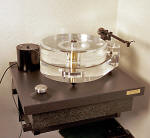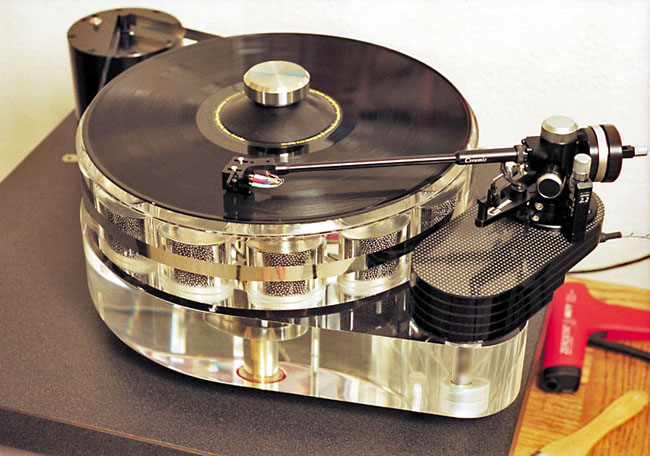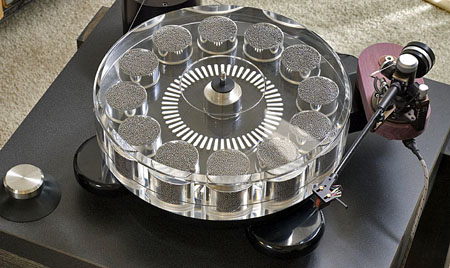-edible zone-
Verus Motor Upgrade for the Teres
Review
Teres 135: assembly and operation
(procedural)
Teres model 135 Review
Motor Pod. looking inside and at the Maxon A-Max 110189 and then how to
get oil to the bushings!
A
Lead-Shot Platter Upgrade
turns it into a Teres 145.
* (click thumbnail for full size image)
(click thumbnail for full size image)
Above: Circa 2002 / 2003. The Teres model 135 with an RB250 tonearm as modified by Expressimo Machine.
*
Above: Circa 2005 / 2006. At this point the Teres has the lead shot platter upgrade, plus an updated platter bearing. This, according to Teres Audio, updates the model number from 135 to 145. A Graham 2.2 tonearm with a Shelter 501-II moving coil cartridge is now in use. The carbon fiber armboard was fabricated by yours truly to fit the Graham. The motor controller (within the motor pod) is by now updated to Signature 2 specification. Later I was to try an Ortofon Jubilee mc cartridge in this setup but after many hours of close listening, I returned to The Shelter cartridge which provided a more immediate sense of delivery than did the Jubilee. At the time I was using a Wright WPP100C phono stage in combination with a step up transformer also provided by Wright Audio.
____________________________________________________horizontal rule
Some thoughts on owning the Teres (circa 2007)
After I had
posted the initial Teres 135 review to both the vinyl asylum and to my
website I found myself answering emails from people thinking seriously
about buying a Teres in one form or another. On the rate of 3 - 4 per
month. Then that began to die down as the whole Teres operation began to
take the form we see now with the new, more upscale models revealing the
direction the company takes.
In the current model lineup I think
the model160 is a good starting point because it includes the lead shot
platter. Hearing what I hear now, I wouldn't even bother with the
standard solid acrylic platter. Further, if you have any lingering
doubts about base construction it would be advisable to simply have
Chris & Co. build you the base. The Brady family were already expert
wood craftsmen before the turntable operation began. Now that they have
been up and running a while, these folks can really turn out some
beautiful turntables.
The principle force behind Teres Audio,
Chris Brady has stated that there is very little sonic difference
between the model 160 and its bigger brother, the 255. The real
difference is aesthetic. The look of exotic hardwoods like the Cocobolo.
http://www.teresaudio.com
Some issues I've watched come and go:
Most problems people have had were controller related. All issues
were resolved as far as I know.
My own controller issues:
1)
silk thread drive. Initially, my Teres 135 came equipped with a straight
pulley with flanges. Unless the table and motor pod were precisely
parallel to each other, the thread would drive up against one flange or
another creating extra drag and, horror of horrors, trigger a speed
correction complete with the audible effects of music slowing down then
speeding back up in correction. The fix was a change in pulley to the
concave silk thread pulley. This appeared to be the cure and Chris
supplied the new pulley designs free of charge to all those who had the
previous design of pulley.
Tape drive notes:
2) Different
drive pulley design. It has a straight drive area, it's taller with a
slight flange at either end to accommodate 1/2 inch belting material.
The pulley installs by simply pushing it onto the motor shaft with hand
pressure.
Tape belting material. 1/2 inch vhs tape would be the
standard belting material. A general consensus is that the shiny side
should be against the driving and driven surfaces when using this belt.
Optional belts include mylar streamer ribbon, available in various shiny
colors, then there is the 1/2 inch vhs semi-clear leader. Others have
experimented with pure silk ribbon
The wider driving belt requires an
even closer parallel alignment between the driving pulley, at the motor
pod and the driven platter, than with the silk thread drive. I've found
it useful to place a single feeler gage (as shim) between one of the
three pod feet and the support platform in order to align the motor pod
to the platter and then leaving it there. Automotive feeler gages are
handy since they come in a set offering .001 inch graduations of size.
This way it is possible to precisely tune for a true running belt.
The Tape drive upgrade was very inexpensive and well worth the extra
effort in setup. Biggest sonic benefit I heard would be attributed to
those qualities closely tied to pace rhythm and tempo. A much more
positive coupling between the driven platter and the driving armature of
that Maxon DC motor. This is very much to the heart of Teres turntable
design philosophy.
Controller upgrades: Over time I have
benefited from 2 different controller upgrades. The first, which Chris
dubbed "The Signature Upgrade", became known as Signature 1 and then
there was a Signature 2 that came later.
From an operational
point of view the "Signature One" upgrade involved swapping out the
controller board within the motor pod and included new stainless steel
cones as pod feet. The cost to me was in the neighborhood of $60 and
worked like an exchange program. I sent in the money to Chris and he
then shipped me another motor pod complete with the new circuit board.
Upon receipt I shipped my old pod back to him. He paid shipping my way,
I paid shipping the way back to him.
The "Signature Two" upgrade
was another controller board evolution. However this time I ended up
receiving the sig 2 upgrade when my sig 1 board experienced a
catastrophic failure. One of the components within the board went "pop",
died, and shut down the whole works. I phoned Chris about this and he
shipped me another motor pod free of charge, this time with Signature II
circuitry. I've been running this pod for the past two years with no
more issues.
The object of both sig 1 and sig 2 controller
upgrades was improved sonic performance. In general I experienced a more
liquid melodic presentation with inner details becoming more apparent.
Pretty good stuff.
Battery Upgrade:
I've had good results
with this inexpensive upgrade and continue to use it. Others have
reported dead batteries at one point or another. Again, Chris has
supported these folks by either selling them a new battery or by
steering them to a vendor who can supply the battery at a competitive
price.
On the negative, this option truly does look like a kit
since it is left up to the owner to devise his/her own enclosure. On the
positive, the lead acid battery is sealed (won't ooze out any nasty
white stuff) and can be placed on the audio rack as is. I've used 4
blobs of Blu-Tack to mount the circuit board directly over the top of
the battery.
For me this has been a substantial sonic upgrade
over the standard power supply. It is used in combination with the same
PS, keeping the cost low. Sweeter melodic presence combined with a
further opening up of inner detail with a more linear high frequency
extension combined with an even better sense of pace and rhythm. That's
what I got with the battery option...!
The Platter upgrade:
The lead shot chambered acrylic platter proved to be a very
substantial sonic improvement that was obvious and easily appreciated.
The additional weight of this platter, nearly twice that of the standard
solid acrylic model, magnifies the moment of inertia out at the platter
rim. The increased momentum of this platter means greater force that is
less likely to be slowed by stylus-to-groove interaction. This change
makes itself known in the sonic sense by delivering a more defined sense
of rhythm. Music has greater toe-tapping, finger-snapping involvement.
Detail levels, dynamics, leading edge transients. These were all
augmented. I also have noticed more definition to the sustain and decay
of notes. Sonic imagery became more apparent, more obvious. What's that
often-used word audio writers resort to...? Palpable! Like an apparition
taking on solid form in the space before you, the sound stage became
better defined with substantial improvements in imaging.
There
was an overall mellowing to the tone of the midrange. Slightly darker,
and smoother. In photography, when lighting gets out of control, we
sometimes experience over-exposed hot spots on the shiny objects. Small
areas of the object become washed out and white, losing definition.
Perhaps something akin to the sonic equivalent of this, a slight amount
of glare was removed with this new platter, leaving in its absence
greater definition to the sonic picture. Those small bits of lost
information are now read with clarity.
Taken altogether, and in
light of the very generous exchange policy currently offered, the
question of whether or not to upgrade from the standard platter to the
lead shot model becomes a no-brainer. It's quite natural. You want this.
